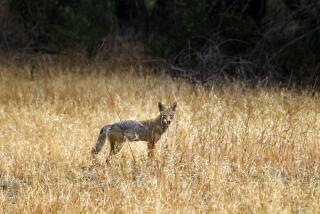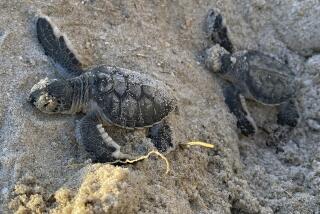Alligator Snappers: Ugly, Tasty . . . Endangered?
- Share via
NEW ORLEANS — It’s a marvelously ugly beast, with spiked and ridged armor, a sharply hooked beak, a fishing lure in its mouth and a nasty bite.
But the alligator snapping turtle’s hard shell holds tasty flesh. Many experts worry that turtle soup will wipe out North America’s biggest freshwater turtle unless Louisiana--the animal’s main turf--protects it.
That doesn’t appear likely any time soon.
It’s a common belief that restaurants use farm-raised alligator snappers, also known as loggerheads and, in Louisiana, cowans. Turtle farmers say that just doesn’t happen.
“A person couldn’t raise alligator snappers for meat and make any money. They grow too slow,” said James Randleas of Randleas Turtle Farm in Jacksonville, Ark. The turtle can grow to 200 pounds and live for more than 70 years.
But by the time they’re old enough to breed--about age 13--they’re just getting big enough to slaughter, with a weight of 25 to 30 pounds.
Buyers Snap Up Turtles
Randleas said his father used to sell wild-caught snappers for meat. Now he raises loggerheads and sells hatchlings overseas or for scientific or educational use. He lists them at $30 to $50 for single turtles, depending on size, wholesale prices negotiated. With six ponds filled with turtles, he figures he sold 10,000 last year.
Randleas’ sales figure sounds incredible for a beast that several international groups say is in trouble and that an American Zoo Assn. committee says is one of three turtles most in need of help.
In addition to chefs and other predators, loggerheads’ perils include pollution, dredging, dams and development. Mercury and dioxin pollute most Louisiana waterways. Dredging kills turtles where they live, at the bottoms of ponds and slow streams. Dams keep them from swimming upriver. Farmland and development have sliced away habitat.
But Louisiana wildlife officials say their studies show the reptile does not need any protecting. And while the 12 other states in the turtle’s range all have laws to protect it, it is not on the federal threatened or endangered species list.
The U.S. Fish and Wildlife Service is considering adding alligator snappers to the international list of species that may not be exported. The International Union for the Conservation of Nature lists them as vulnerable--a species that may soon become endangered.
Yet in Louisiana, state wildlife officials say cowans are doing fine on their own.
Jeff Boundy of the Louisiana Department of Wildlife and Fisheries, who ran a program to learn how many are in Louisiana, said they don’t need protection and he won’t recommend it.
Over five years, Boundy said, trappers caught, weighed, measured and tagged about 500 alligator snappers around the state. What’s most significant, he said, is that the trappers found about the same numbers in wildlife reserves as in areas where turtles were caught for market.
Alligator snappers spend most of their time in the muck at the bottom of ponds and slow streams, surfacing only to breathe, breed and get a bite to eat.
A Taste for Veggies
Many people think the turtles are carnivores, and they do have a wiggly worm-like lure in their mouths, which helps attract fish. But a study of 65 slaughtered in 1986 found that vegetation made up two-thirds of their stomach contents. More than half was acorns.
John Richards, who created the Alligator Snapper Foundation to raise loggerheads in Strafford, Mo., rejects Boundy’s optimism.
“There’s no doubt that four-fifths of your turtles--your alligator snappers--are gone,” he says vehemently. “This animal has a lot of factors working against it that weren’t working against it 30 or 40 years ago.”
Ironically, that includes the Endangered Species Act. When the act became law in the early 1970s, it became illegal to catch sea turtles for their meat.
Mock turtle soup went on menus around town, with meat from a substitute reptile--or even a mammal. “They would use alligator or pork, grind it up and use it the same way. It tastes very similar,” said David Gooch, a member of the family that owns New Orleans’ renowned Galatoire’s Restaurant.
When the giant freshwater turtles went into the pot, the result could once again be called turtle instead of mock turtle soup.
By 1993, when Arkansas made it illegal to catch loggerheads or take their eggs, they could not be found at all in many Arkansas lakes and streams, said Len Pitcock, Game and Fish Commission spokesman.
They now seem to be recovering in Arkansas. Biologist Kelly Irwin said limited trapping last year turned up younger animals, indicating that they are reproducing.
Mike Harrell, who has caught about 200 in north Louisiana over the past two years, agrees with Boundy that Louisiana holds far more alligator snapping turtles than most researchers think. But they still need help, he says.
He’s doing what he can, putting money he makes working nights into a “head start” project to raise hatchlings for release once they are big enough to have a good chance of surviving. The adults he catches are parent stock.
He has yet to release any, but he said the number of hatchlings rose from hundreds in his first two years to a couple of thousand this year.
In the wild, most eggs and most hatchlings get eaten by raccoons, opossums and other predators. If a turtle lays 25 eggs--an average wild clutch--one hatchling may make it through a year in the wild.
In the meantime, Harrell is feeding the turtles about 700 pounds of fish a week--fish that commercial fishermen would otherwise throw back--and whatever water plants he sees choking local waterways.
“Those turtles are one of the few things out there that are really eating it,” he said. “I can throw it in the water and in just a day they’ll have eaten every bit of it. I can throw in a truckload and they’ll eat it all.”
More to Read
Sign up for Essential California
The most important California stories and recommendations in your inbox every morning.
You may occasionally receive promotional content from the Los Angeles Times.













